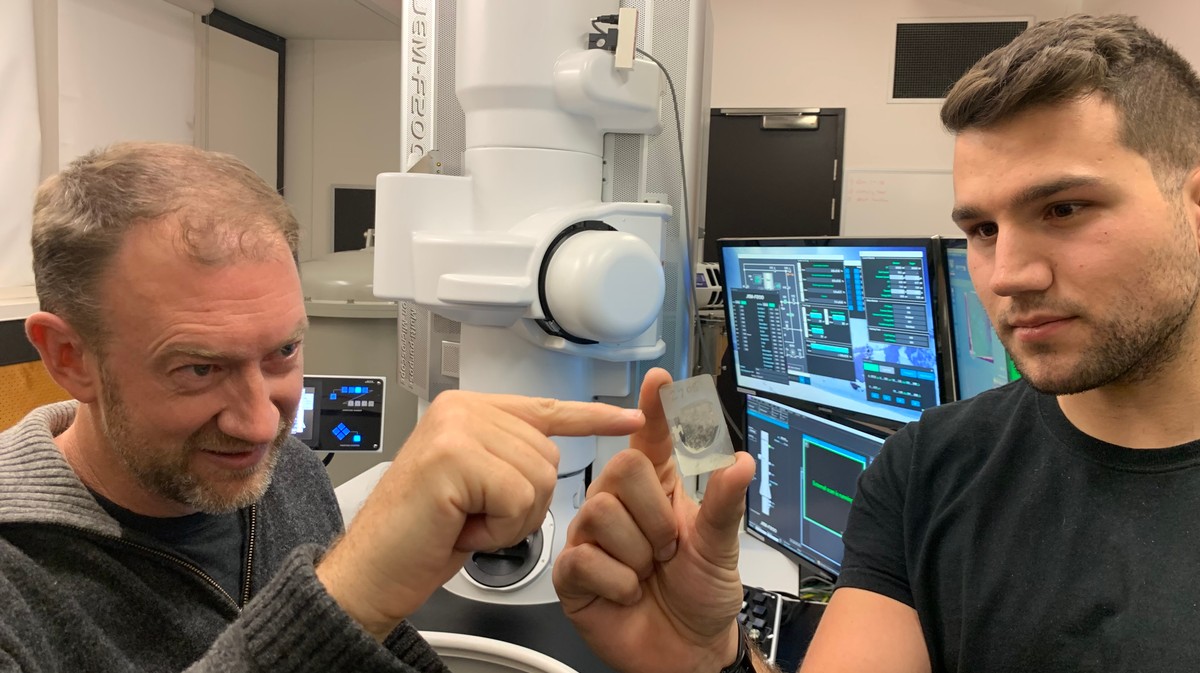Monash University Professor Andy Tomkins (left) with RMIT University graduate student Alan Salek holding a Uereilite meteor sample at the RMIT Microscopy and Microanalysis Facility. Image: RMIT University
ABSTRACT breaks down amazing scientific research, future technologies, new discoveries and major breakthroughs.
Billions of years ago, at the dawn of our solar system, an asteroid shattered a dwarf planet in a catastrophic collision that blasted the planet’s interior into space. Over time, remnants of the dwarf planet’s mantle have accidentally fallen to Earth as diamond-rich meteorites called ureilites, offering an unprecedented glimpse into the subterranean strata of a doomed ancient world.
For years, scientists have puzzled over the fallen remains of the long-lost planet and the mysterious presence of its abundant diamonds, which contain evidence of Lonsdaleit, an extremely rare type of diamond named after pioneering crystallographer Kathleen Lonsdale.
Now, scientists led by Andrew Tomkins, a professor of geosciences at Monash University, have found the largest Lonsdaleit diamonds ever seen in ureilites, conclusively confirming their existence in the meteorites. The team proposed “a unique model for ureilites that can reconcile all conflicting observations related to diamond formation” and that could ultimately inspire novel industrial applications a study published on Monday in Proceedings of the National Academy of Sciences.
“We’ve known about diamonds on Ureilites for some time,” Tomkins told Motherboard in an email a recent study who studied the origins of these materials. “While doing this work, I looked through my microscope at the diamonds in various samples and noticed that one of them contained some unusually folded diamonds. For a geologist, that was completely odd — diamond is the hardest material known, so it shouldn’t be possible to bend it.”
“This sparked my interest in pursuing this line of research,” he continued, prompting the involvement of his co-authors from the Commonwealth Scientific and Industrial Research Organization and the Royal Melbourne Institute of Technology. “From there we produced the story that we have. These folded diamonds turned out to be an unusual hexagonal diamond shape known as Lonsdaleit.”
While previous studies have found evidence of lonsdaleite in ureilites, Tomkins and his colleagues used advanced electron microscopy to discover lonsdaleite crystals measuring up to a micrometer in size, which is about 70 times smaller than the width of a human hair. Although this may seem tiny, these Lonsdaleite fragments are larger than anything previously seen in the space rocks.
This level of detail helped the researchers find what the study calls “the only known solution” to the problem of how post-ancient impact Lonsdaleit and diamonds were forged without the presence of catalyzing metals, the study said. The team suggested that Lonsdaleite formed from hot fluid that flowed after the collision, eerily preserving the properties of the graphite already present in the mantle.
Part of the Lonsdaleit was replaced with traditional cubic diamonds as the rock cooled, creating the distinct patterns seen in ureilites according to the new model. The process, known as chemical vapor deposition (CVD), is like a natural version of a manufacturing technique used to create synthetic diamonds under laboratory conditions.
“I had thought early on that the diamonds might have formed by CVD, but when we found the Lonsdaleit and then found an evolution from Lonsdaleit formation to diamond, there had to be an explanation that fitted the known evolution of the ureilite parent asteroid,” Tomkins said. “This is the fit that made the best sense with the observations we had.”
“It adds to the story of the complex chemistry that happened after the catastrophic disruption event,” he noted. “Scientists have known about this event for a long time, but no one had realized that diamonds and Lonsdaleite were likely forming at this point.”
The results not only shed new light on these naturally occurring space diamonds, but may also inspire creative approaches to the manufacture of synthetic Lonsdaleite and diamonds. Because Lonsdaleit is even harder than regular diamond, it has many potential applications in materials science, including gears in miniature machines. This is far from the first time diamonds forged in space have served as models for industrial manufacture; scientist recently turned plastic into diamonds by replicating the conditions in Uranus and Neptune.
“Basically what we found is a situation where some graphite shapes — the wrinkle shapes — were replaced with Lonsdaleit, which preserved the same shape almost perfectly,” Tomkins said. “So the thought is that in the laboratory it might be possible to replicate this natural process. It should be possible to make components out of very soft graphite and then turn those shapes into Lonsdaleite. It’s really up to the engineers to find applications for such a technique – there must be many possible applications.”
“The next plan is to conduct experiments that try to replicate the natural process that formed the Lonsdaleit,” he concluded. “Who knows, we might be the first to figure out how to make these ultra-hard micromachine components.”

